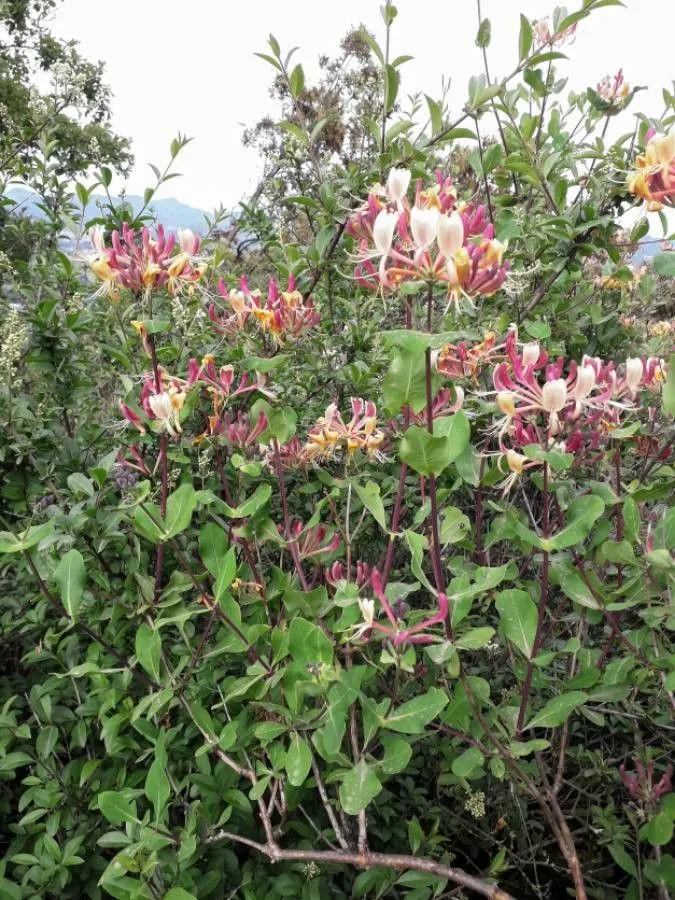
Author: Santi
Bibliography: Viagg. Montamiata: 113 (1795)
Year: 1795
Status: accepted
Rank: species
Genus: Lonicera
Vegetable: False
Observations: SC. Europe to Medit. and W. Caucasus
Etruscan honeysuckle, known scientifically as Lonicera etrusca, is an enchanting plant species belonging to the Caprifoliaceae family. This delightful climbing shrub thrives across regions spanning from Southern Europe to the Mediterranean and Western Caucasus. The plant was first documented by Santi in 1795, in his travels through Montamiata, offering valuable insights into its natural habitat and characteristics.
The Etruscan honeysuckle is renowned for its vigorous growth and decorative appeal. Typically found draping elegantly over fences and trellises, it creates a stunning visual display in gardens and natural landscapes. Its twining stems and lush foliage provide a verdant backdrop that highlights its true decorative gems: the flowers.
During the blooming season, Lonicera etrusca produces clusters of tubular flowers that are a feast for the eyes and attract a myriad of pollinators. These fragrant blooms are usually creamy yellow with a hint of pink or reddish hues, adding a warm and inviting splash of color to their surroundings. Aside from their aesthetic appeal, the flowers emit a sweet, intoxicating scent, especially in the evening, enhancing the sensory experience of any garden.
Beyond its visual and olfactory beauty, the Etruscan honeysuckle also plays an important ecological role. The nectar-rich flowers are a favorite among bees, butterflies, and hummingbirds, contributing to local biodiversity and supporting key pollinators.
Cultivating Etruscan honeysuckle is relatively straightforward. The plant favors sunny to partially shaded positions and well-drained soils. It is hardy and can tolerate a range of conditions once established, making it a versatile addition to various garden designs. Regular pruning helps manage its growth and encourages a more abundant floral display.
The Etruscan honeysuckle is not only an ornamental treasure but also a symbol of the rich botanical heritage found in its native regions. Its presence in gardens and landscapes across the world serves as a living testament to the beauty and diversity of the natural world.
Eng: etruscan honeysuckle
Deu: etruskische heckenkirsche, etruskisches geißblatt, toskanisches geißblatt
Swe: orangekaprifol
Fra: chèvrefeuille d’étrurie, chèvrefeuille de toscane
En: Etruscan honeysuckle
Ca: Lligabosc etrusc
Nl: Etruskische Kamperfoelie
Fr: Chèvrefeuille d’Étrurie, Chèvrefeuille de Toscane
De: Toskanisches Geißblatt, Etruskische Heckenkirsche, Etruskisches Geißblatt, Etrurisches Geißblatt
It: Caprifoglio etrusco
Es: Madreselva, Matahombres
Sv: Orangekaprifol
Taken May 25, 2018 by Pep Secem (cc-by-sa)
Taken May 26, 2019 by Mary Mary (cc-by-sa)
Taken May 28, 2017 by Mario Cman (cc-by-sa)
Taken May 25, 2018 by Pep Secem (cc-by-sa)
Taken May 25, 2018 by Pep Secem (cc-by-sa)
Taken Aug 19, 2020 by Alain Bigou (cc-by-sa)
Taken Aug 3, 2020 by juan llanos (cc-by-sa)
Taken Aug 3, 2020 by juan llanos (cc-by-sa)
Taken Aug 3, 2020 by juan llanos (cc-by-sa)
Taken Sep 7, 2017 by Marc-alain Bahuchet (cc-by-sa)
Taken Jul 24, 2022 by Aline Barré (cc-by-sa)
Taken May 7, 2019 by Llandrich anna (cc-by-sa)
Taken May 28, 2017 by Mario Cman (cc-by-sa)
Taken May 27, 2020 by juan llanos (cc-by-sa)
Taken May 25, 2018 by Pep Secem (cc-by-sa)
Taken Jul 1, 2021 by Alain Bigou (cc-by-sa)
Taken May 7, 2019 by Llandrich anna (cc-by-sa)
Taken Jun 20, 2015 by Miguel A. C. (cc-by-sa)
Taken May 25, 2018 by Pep Secem (cc-by-sa)
Taken May 25, 2018 by Pep Secem (cc-by-sa)
Taken May 25, 2021 by Barry Cornelius (cc-by-sa)
Taken Jun 5, 2021 by alexandra desloyal (cc-by-sa)
Taken May 20, 2021 by Margit Glassel (cc-by-sa)
Taken May 7, 2019 by Llandrich anna (cc-by-sa)
Taken May 7, 2019 by Llandrich anna (cc-by-sa)
Taken May 18, 2015 by Tela Botanica − unknown (cc-by-sa)
Taken May 27, 2006 by Tela Botanica − Françoise CARLE (cc-by-sa)
Taken Nov 21, 2020 by philippe sladden (cc-by-sa)
Taken May 13, 2022 by Fabrice Rubio (cc-by-sa)
Taken Jul 1, 2021 by Alain Bigou (cc-by-sa)
© copyright of the Board of Trustees of the Royal Botanic Gardens, Kew.
© copyright of the Board of Trustees of the Royal Botanic Gardens, Kew.
© copyright of the Board of Trustees of the Royal Botanic Gardens, Kew.
Growth habit: Vine
Ph maximum: 7.0
Ph minimum: 6.5
Light: 7
Atmospheric humidity: 5
Bloom months: [‘may’, ‘jun’, ‘jul’]
Soil nutriments: 5
Family: Myrtaceae Author: (F.Muell.) K.D.Hill & L.A.S.Johnson Bibliography: Telopea 6: 402 (1995) Year: 1995 Status:…
Family: Rubiaceae Author: Pierre ex A.Froehner Bibliography: Notizbl. Bot. Gart. Berlin-Dahlem 1: 237 (1897) Year:…
Family: Sapindaceae Author: Koidz. Bibliography: J. Coll. Sci. Imp. Univ. Tokyo 32(1): 38 (1911) Year:…
Family: Asteraceae Author: A.Gray Bibliography: Pacif. Railr. Rep.: 107 (1857) Year: 1857 Status: accepted Rank:…
Family: Fabaceae Author: Medik. Bibliography: Vorles. Churpfälz. Phys.-Ökon. Ges. 2: 398 (1787) Year: 1787 Status:…
Family: Aspleniaceae Author: (Cav.) Alston Bibliography: Bull. Misc. Inform. Kew 1932: 309 (1932) Year: 1932…